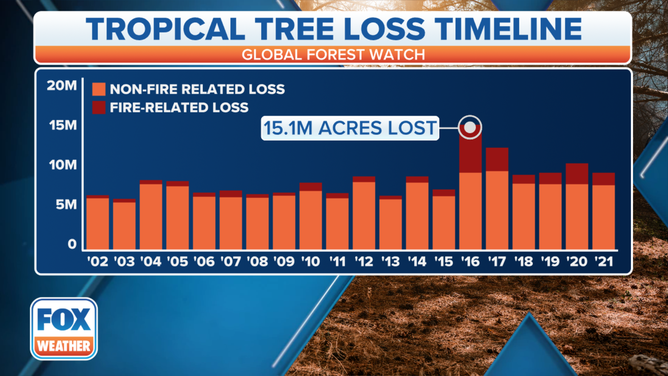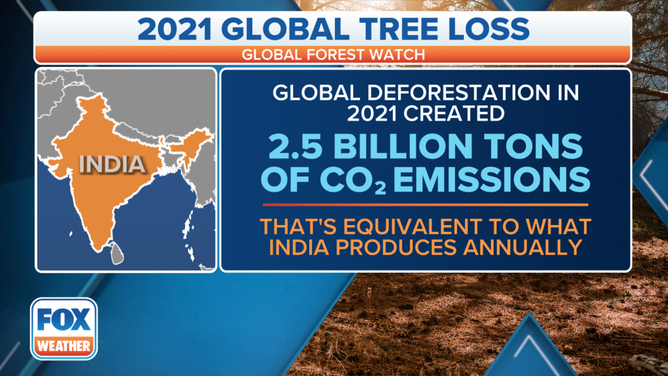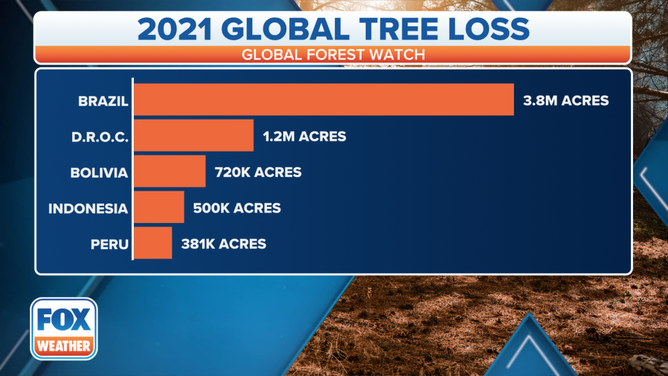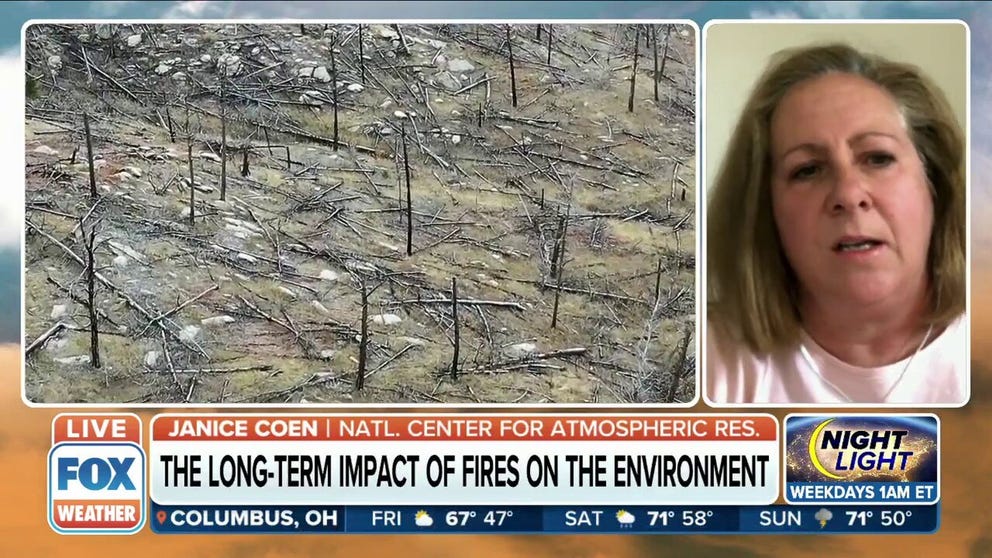Unprecedented wildfires drove global tree loss in 2021
Peatlands and rainforests are Earth's natural carbon storage. Deforestation led to 2.5 billion tons of additional carbon dioxide emissions last year.
Unprecedented wildfires helped fuel global forest losses in 2021
Mikaela Weisse, Deputy Director of Global Forest Watch, joined FOX Weather to talk about the global trends of forest loss due to wildfires from 2001 to 2019.
Researchers behind a new study from the University of Maryland and the Global Forest Watch on tree cover loss found unprecedented wildfires last year caused massive forest loss across the globe.
The UMD research team reviewed nearly 20 years of satellite data at a 30-meter resolution mapping forest loss due to wildfire and found an increasing global trend of tree loss from 2001 to 2019 across all forest ecosystems, including tropics, subtropic, Australia and northern boreal forests in Eurasia.
The Global Forest Watch, which is part of the World Resources Institute, releases a report every year on forest losses. This is the first time wildfire data helped detail patterns of tree cover loss from fires.
Boreal or sometimes called snow forests are found in North America, China, Finland, Japan, Norway, Russia and Sweden because they grow in high-latitude environments with 6 to 8 months of freezing temperatures, according to the International Boreal Forest Research Association.
Bolivia and Russia experienced massive tree loss in 2021, primarily driven by fires.
Russia experienced the worst fire season since 2001, with 16.1 million acres of tree cover lost in 2021. About 80% of that loss was due to fires.
Wildfires threaten Earth's largest natural form of carbon storage

Tropical tree loss over the years due to fires and other related causes. Data from the Global Forest Watch.
Deputy Director of Global Forest Watch Mikaela Weisse said that while fires are a natural part of boreal forest ecosystems, larger and more intense fires are concerning, especially in Siberia's peatland area.
Peatlands are a type of wetlands and the most prominent natural form of carbon storage on Earth. Wildfires can cause massive amounts of stored carbon to be released when peat is burned, and permafrost melts.
Significant forest loss in boreal and subtropical regions of globe, says scientist
Project Scientist at the National Center for Atmospheric Research Janice Coen weighs in on the study that discovered forest loss from 2001-2019 due to wildfires.
"This can lead to a feedback loop in which hotter, drier conditions related to climate change lead to increasing fires, which leads to increasing carbon emissions, which lead to hotter and drier conditions," Weisse said.
Wildfires have caused 90 million hectares (222 million acres) of loss between 2001 and 2021.
More than 96% of human-caused deforestation occurs in the tropics, whereas boreal and temperate forest loss is primarily caused by forestry and wildfires.
Last year, more than 27.5 million acres of tree cover in the tropics were whipped out. The same area would cover most of New England.

Globally more than 27.5 acres were lost in 2021, according to data from the University of Maryland and Global Forest Watch
Wildfires contribute to greenhouse gas emissions, impacting health and ecosystems, but the loss of forests across the world is driving up fossil fuel emissions.
Tropical rainforests are a significant source of absorbing carbon. Fewer trees mean more carbon dioxide.

Global forest loss created 2.5 billion tons of carbon dioxide emissions in 2021.
Brazil remains the country with the greatest forest losses, with 3.8 million acres in 2021. This year's data on tree losses in the Amazon was especially concerning because new research shows the rainforest is losing resilience.
"[The Amazon] may be closer than we originally thought to reaching a tipping point, which is a point where vast areas of the Amazon would transform from a rain forest to a savanna resulting in massive carbon emissions," Weisse explained.
Deforestation worldwide led to 2.5 billion tons of additional carbon dioxide emissions last year. That's about what India produces in a year in fossil fuel emissions, according to the Global Forest Watch.
Experts report good news in Indonesia but say more action is needed

Top areas with tree loss for 2021, according to Global Forest Watch data.
There was some good news in the 2021 forest loss report.
This century, Brazil and Indonesia have experienced the largest area of tree loss. However, forest losses have declined in Indonesia for the past five years.
In 2021, Indonesia experienced a 25% decline in primary forest loss compared to 2020.
"Some things I think that have worked well in Indonesia are government actions but also private companies that are taking action to remove deforestation from their supply chains," Weisse said, adding public and private sector efforts could work in other countries.
Another promising step was that 141 countries agreed to stop and reverse forest loss by 2030 under the 2021 Glasgow Leaders Declaration on Forests and Land Use pact. But it's still too early to see the benefits of that pledge.
"There are only eight years left in 2030, so we are going to have to see massive declines in forest lost if we want to get to zero by the end of this decade," Weisse said.

